We are looking for an answer to the question of what innovations in the history of shipbuilding made it possible for Christopher Columbus to reach America and return to Europe, to Lisbon. There are three most important innovations of building ships: first the frame structures, and the use of the lateen sail and the rudder. The Portuguese were the first to build first the frame on keeled ships, the caravels around the 1440's, and later the larger carracks. The discovery of the coasts of Africa was the direct reason for the construction of keeled ships, and the construction of ships of first the frame with strengthening of the planking made further geographical discoveries possible. Initially, the Portuguese explored the African coast, until the Gold Coast and the Azores. There is no direct evidence, but it is very likely that Henry the Navigator had the first who Built kelled ships, the caravels in Europe in the 1400s in Lagos, Portugal. Several voyages of discovery were commissioned by Henry the Navigator to Africa, Azores were discovered. The Portuguese version of the caravel was developed from local fishing boats, from barinels. Arab influences - the spread of the triangular lateen sail and the rudder attached to the stern - determined the good navigational capabilities and maneuverability of the ocean-going caravels. Ships built for the ocean were built with high side planks, to withstand larger waves and to store supplies for many days or weeks. However, keeled ships were lighter, about half as heavy as the ships built using the first shipbuilding method of joining the planks. The carvel planks were fastened together with pins and thin ropes, "sewing", by carving grooves into the planks. The carvel planks did not leak as much as the clinker-planked Viking ships. In the Baltics, ships with "sewn" pin-and-pin carvel planks were built even in the 19th century, because it was a cheap, waterproof method of shipbuilding. The planks were not pierced for the "sewing", but fibrous plant debris, cord, or possibly twigs were pressed between the planks.
Ships built first the frame on keel are those wooden ships in which the crossbeams and ribs are first attached to a bottom beam, the keel, and only then is covered with planks. Ships were previously built with a bottom beam*, which was mounted under the already reinforced planks, and its function was to protect the bottom of the ship (false keel*) when towing or running ashore, and also to keep the ship directional (keel*). In the first half of the 15th century, Portuguese caravels, and then carracks, which fit into our childhood fairy tales, were the first keeled ships.
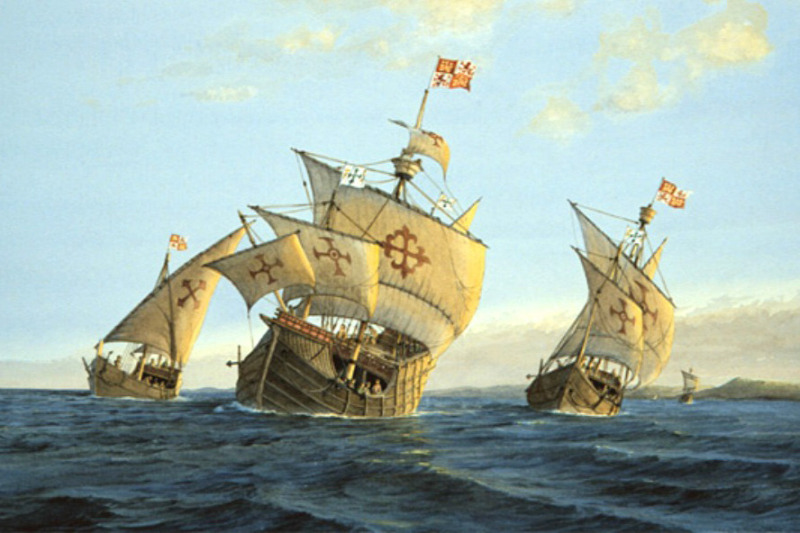
Columbus' ships, two caravels and a carrack in the middle (the latter also known as a nao
https://hu.wikipedia.org/wiki/Kolumbusz_Krist%C3%B3f)
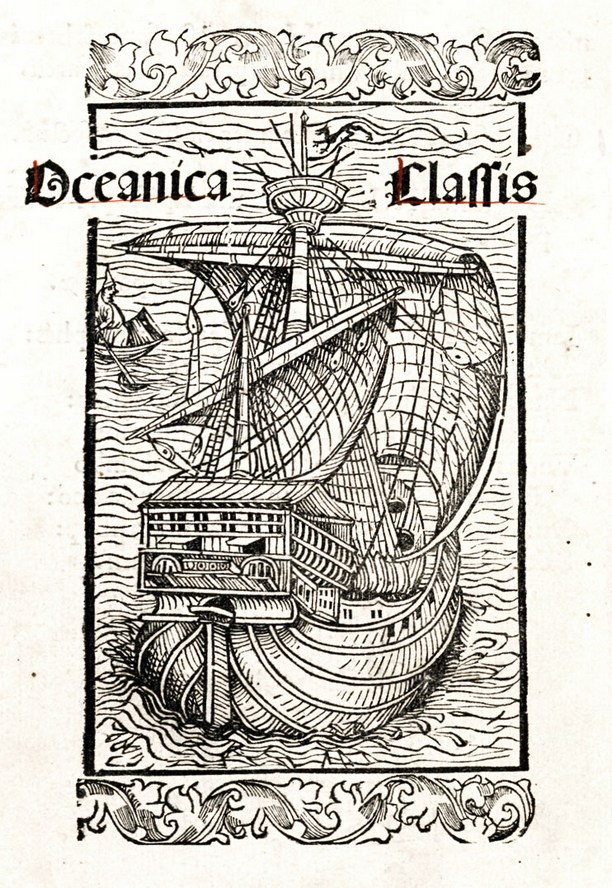
Christopher Columbus's ship Santa Maria, carrack. The engraving was published in 1493, after Columbus' first voyage
(https://hu.wikipedia.org/wiki/Kolumbusz_Krist%C3%B3f)
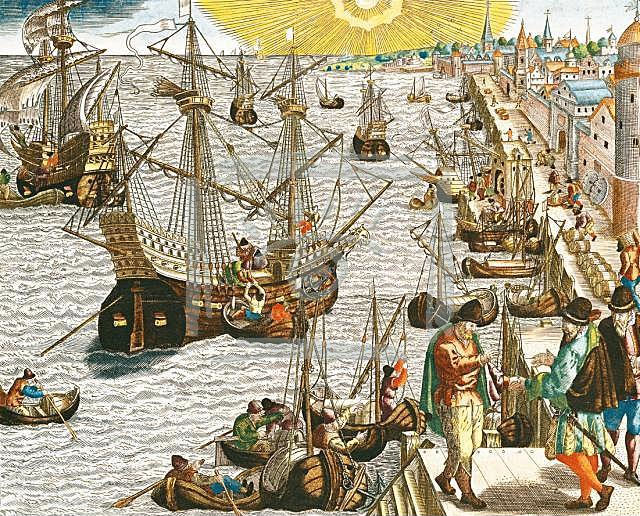
From the 12th century onwards, Latin sail ships began to be built in the Mediterranean. Before that, square-rigged ships with keels were built. The origin of the keel: the Phoenician Ugarites (Syria) introduced the keel* to Egypt in the 1600s BC in their capital city of Avaris in the Nile Delta. The keel* is a bottom beam that ensured the direction of sailing ships in crosswinds and served to protect the bottom of the hull when running aground. It consisted of several pieces. Later, the keel was carved from a single beam whenever possible.
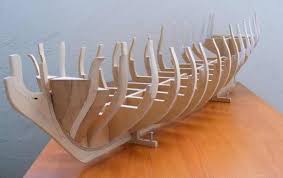
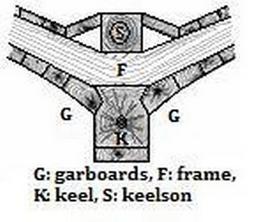
Keel and inner bottom beam marked with the letters K and S, the ship slid on the unmarked rubbing beam under the keel when it ran aground on the shore.
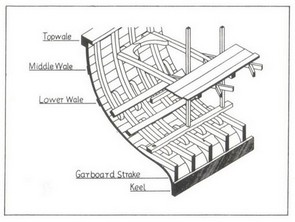
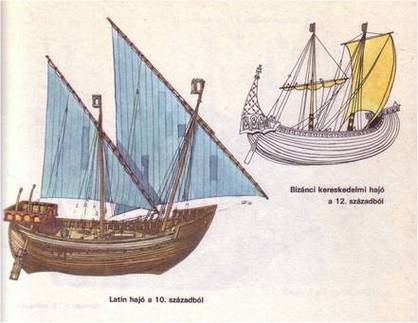
(GULAS, Stefan - LESCINSKY, Dusan: The History of Sailing Ships, Madách Publishing House, Bratislava 1984.)
The word keel generally refers to the directional bottom beam, the ship's capital, on which the bulwarks, as well as the bow and stern, are built. Many meanings are known:
- the keel is built under the ship to maintain direction, if it has an effective vertical dimension, it is often used in this sense, the original meaning of the word is: direction holder
- a false keel is a bottom beam, it protects the bottom of the ship,
- ballast keel, i.e. capital weight,
- keelson, i.e. inner bottom beam, to distribute the weight of the masts and deck, (and in the examined era the bottom beams were not yet extended, the meaning of the whip beam is inRoman warships.
Origin of the rudder, the straight stern: the Hariri Codex ship depiction of an Arab ship with a rudder around 1100:
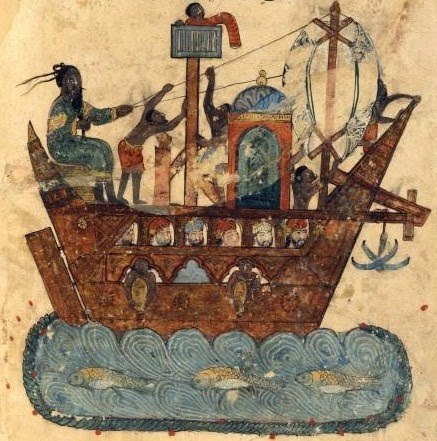
(https://www.facsimilefinder.com/facsimiles/maqamat-al-hariri-facsimile)
From the 13th century onwards, the use of rudders replaced oars in the Mediterranean, although the latter were still in use in Venice in the 15th and 16th centuries. The rudder, which originated in China and was brought to the Mediterranean via Arabia, the keel (which originated in Portugal, possibly via Arabia), the lateen sail (which originated in Roman times, possibly via Arabia), and the use of cannons (of Chinese origin, together with gunpowder, around 1100) spread over the centuries. The rudder was mounted on the sternpost, the stern, a straight sternpost. Straight sternposts had been used in the Aegean Sea for more than 3,000 years at that time, https://www.researchgate.net/figure/Obsidian-sources-Milos-Antiparos-Yali-and-their-distribution-in-the-Aegean-area_fig1_243960112, https://en.wikipedia.org/wiki/Milos, e.g. to the island of Milos for obsidian, and earlier with reed boats.
It is possible that the rudder was also invented in the north: it first appeared on a carved relief on the baptismal font of Winchester Cathedral around 1180, then on the 13th-century seals of Dam and Ipswich and on a depiction carved into the wall of the Fide Church on Gotland (an island near Stockholm) (https://nautarch.tamu.edu/pdf-files/Mott-MA1991.pdf). It can also be seen on a carving on a coat of arms in southern England:
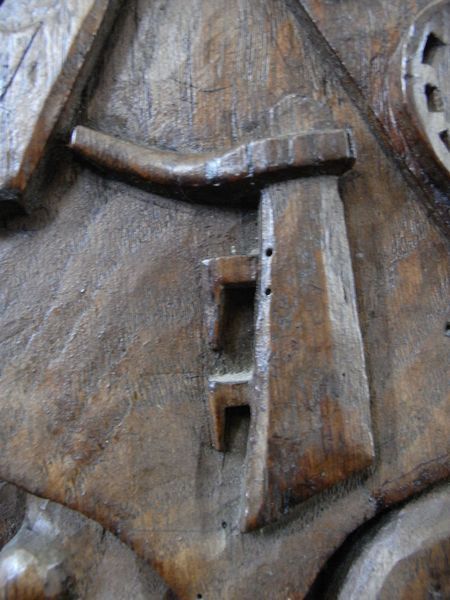
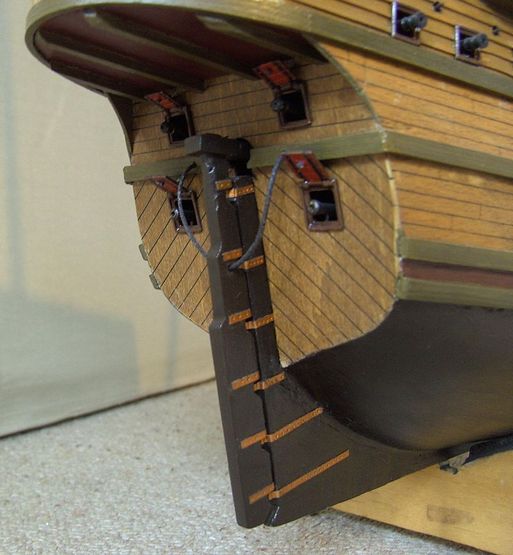
The first appearance of the rudder in Europe is unclear. Some experts believe it arrived in Europe from China via Arabia, while others believe it appeared in the North Sea and Baltic Sea on cog-type ships used for Hanseatic trade (https://en.wikipedia.org/wiki/Rudder). Baltic cog ships were also originally ships without keels. The connections between the vertically placed support beams holding up the ship's deck required a solid foundation, so an internal longitudinal beam (keelson*) was built into the bottom of the ship.
In the Baltic Sea, ships used in Hanseatic trade, such as cogs and hulks, commonly used rudders, which were quickly adopted by caravel builders due to their ease of steering.
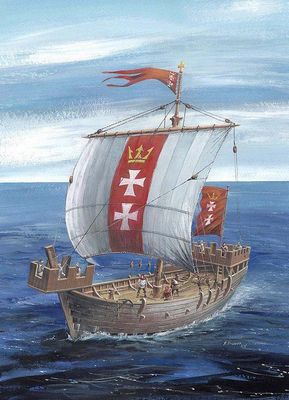
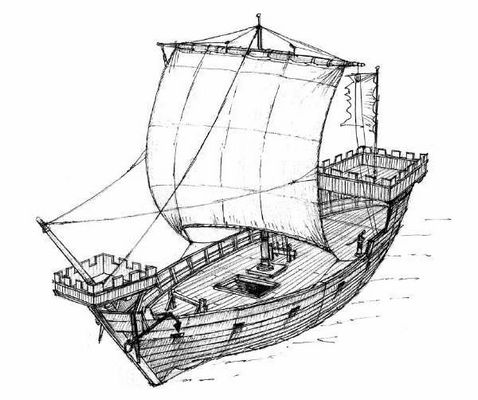
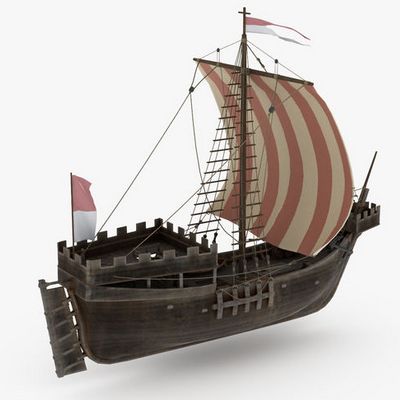
Most Baltic hulks are large displacement, three-masted cargo ships with square sails on the foremast and mainmast and lateen sails on the mizzenmast. The size of the fore and aft superstructures was the same, and they were rectangular in shape. (https://hu.wikipedia.org/wiki/Hulk_(haj%C3%B3))
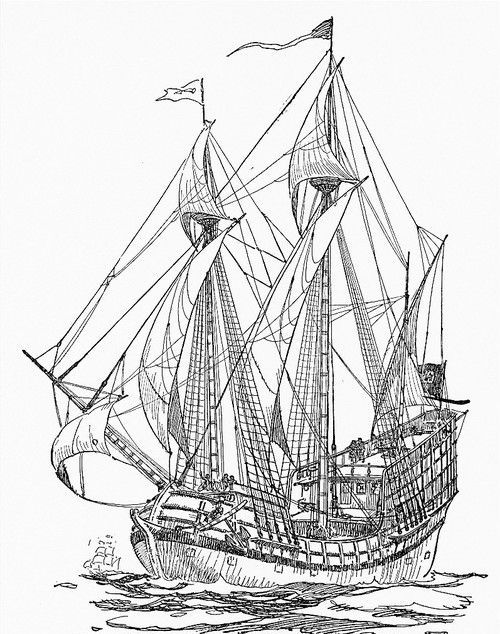
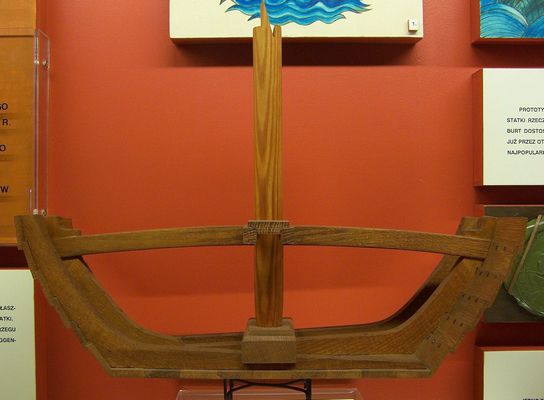
The direct predecessors of keelboats, called barinels, were built in Portugal in the 14th century. These were not yet keel-built ships, but were used as military and exploration vessels, with a crew of 30 rowers. The barinel was built to be stronger than other ships in the 1440s, with a lateen sail. (https://pt.wikipedia.org/wiki/Barinel). Based on the images, the barinel differed little from the caravels:
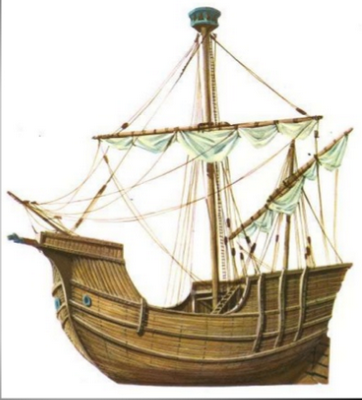
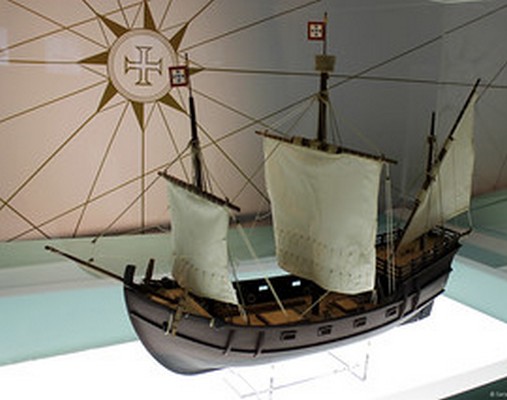
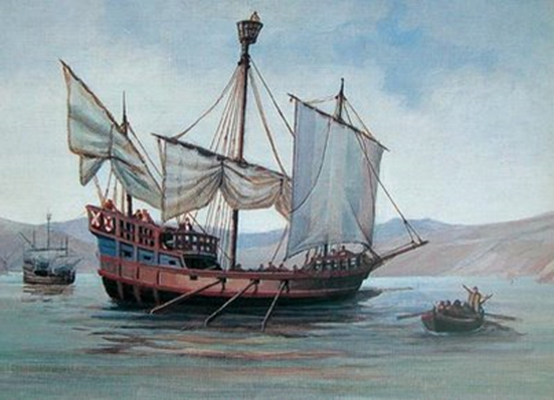
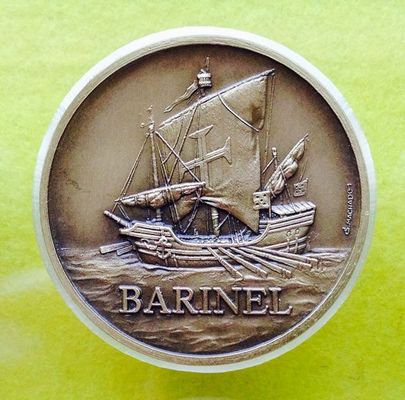
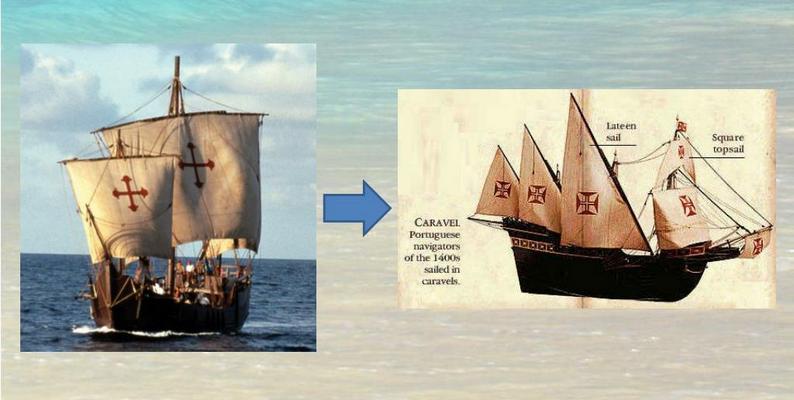
The passage of Cape Bojador was one of the most important milestones in navigation. It overturned the old myths of impossibility of circumnavigation and opened the way for great discoveries. By passing Cape Bojador, Portuguese sailors entered previously unknown seas, where they had to face many other dangers." (https://pt.wikipedia.org/wiki/Cabo_Bojador).
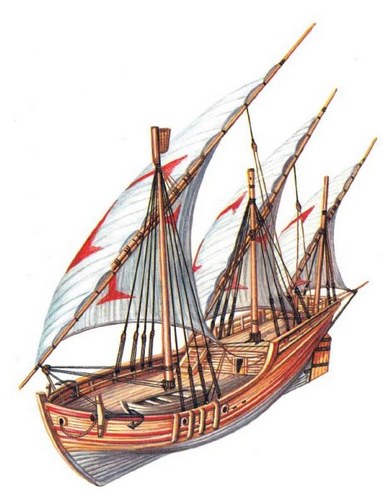
Early caravels were single-masted, square-rigged or lateen-rigged ships with a 4:1 length ratio, a caravel, a rudder and a raised stern, and a single deck. The early type (13th–15th centuries) was small, strong and fast, with a displacement of about 20 gross tons. The multi-masted ones usually had lateen sails on two or three masts, or mixed (two square-rigged and one lateen on large ships). Their crew consisted of about 20 men, which corresponded to their original function: in the 13th century, the first caravels were fishing boats used along the coast. The later caravel was 20–25 m long, 6–7 m wide, and displaced 200–400 gross tons. This was the "cross-sailed caravel" which also had a small cross-sail (artemon sail) on the foremast, and a topsail above the mast basket, or topsail. The lateen sail remained on the aftermast. With the displacement of water, the number of masts increased further: eventually, four-masted caravels were also built. The seaworthiness of the cross-sailed caravel was outstanding for its time. It was the first type of large ship that could sail sharply into the wind. Portuguese sailors sailed along the coast of West Africa to the Gold Coast and even slightly beyond on such so-called lateen caravels. The simple ship had many advantageous features; the most important of which were that it was maneuverable, built with a rudder, could sail well against the wind, and had high sides against large ocean waves.
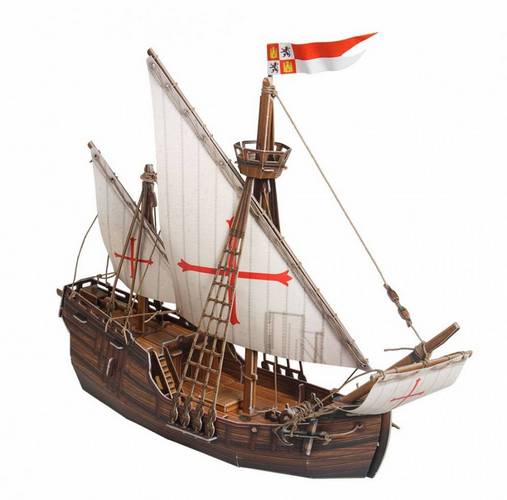
The caravel had high sides, a deck, and a high stern structure, while in the 13th century the first caravels were still coastal fishing boats. Portuguese sailors reached the coast of West Africa beyond the Gold Coast on lateen sail caravels. (https://mek.oszk.hu/01200/01267/html/06kotet/06r04f25.htm) The lateen sail ship was unusually large for the time It was a fast and agile ship. With the displacement of water, the number of masts increased to four. Its speed reached 11 knots, one international knot is one nautical mile per hour. One nautical mile per hour is 1.852 km/h, so a speed of 11 knots is 20,372 km per hour.
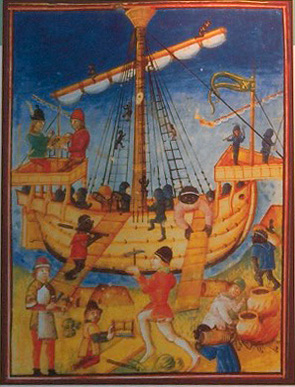
(https://en.wikipedia.org/wiki/Lagos)
Christopher Columbus set sail on his expeditions with two caravels and a nao (of his three ships, the Niña and the Pinta were caravels, while the Santa Maria was a carrack (nao): the Italian Columbus, commissioned by Spain, arrived in Lisbon in a Portuguese ship). Later, Vasco da Gama did the same. A few pictures of late caravels, few pictures are available:
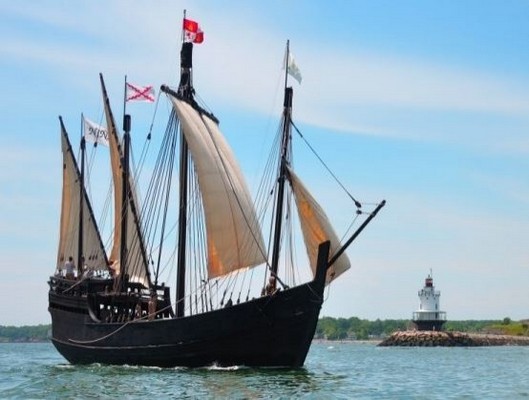
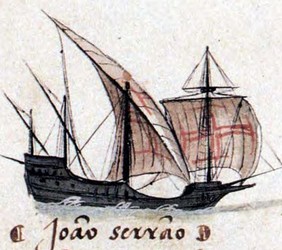
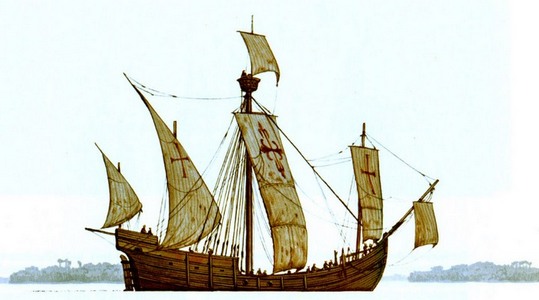
Caravel: Developed in Portugal, its ancestors probably included Arab ships. The first written mention of it dates back to 1255.
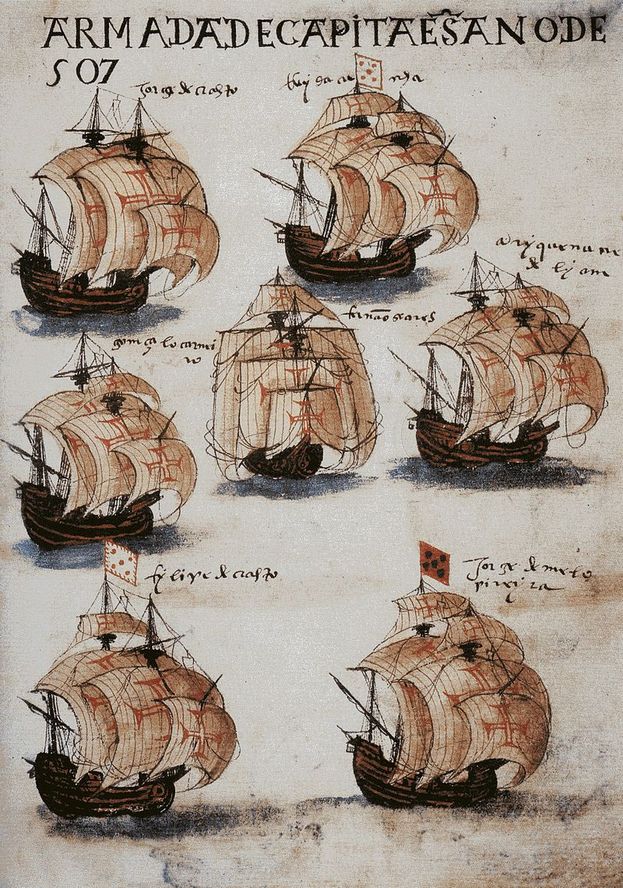
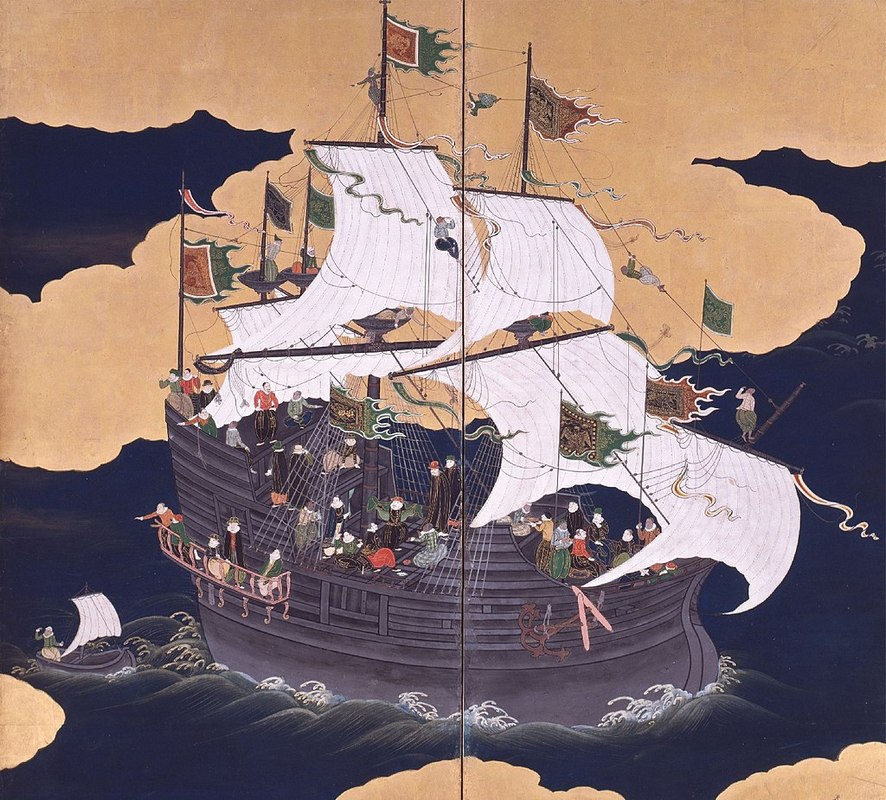
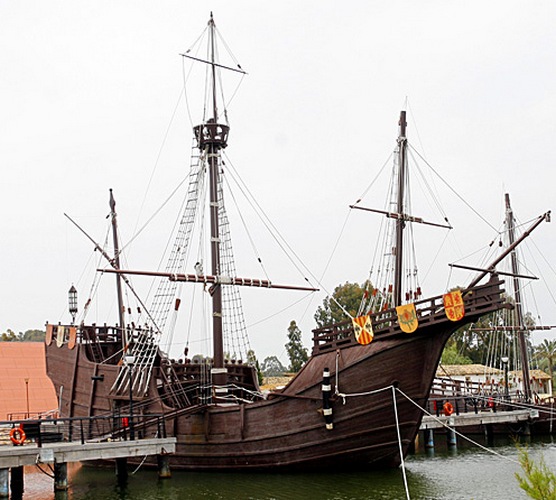
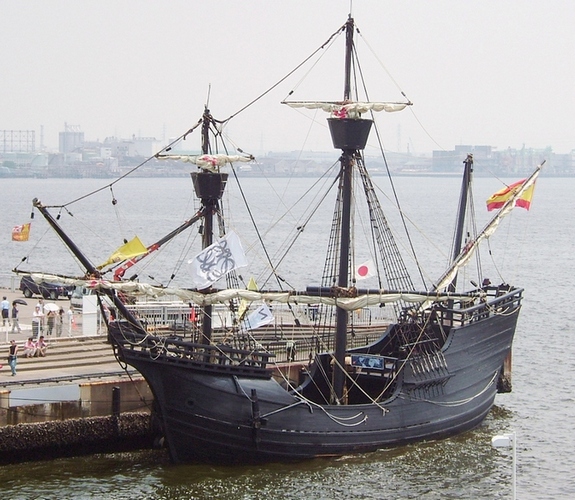
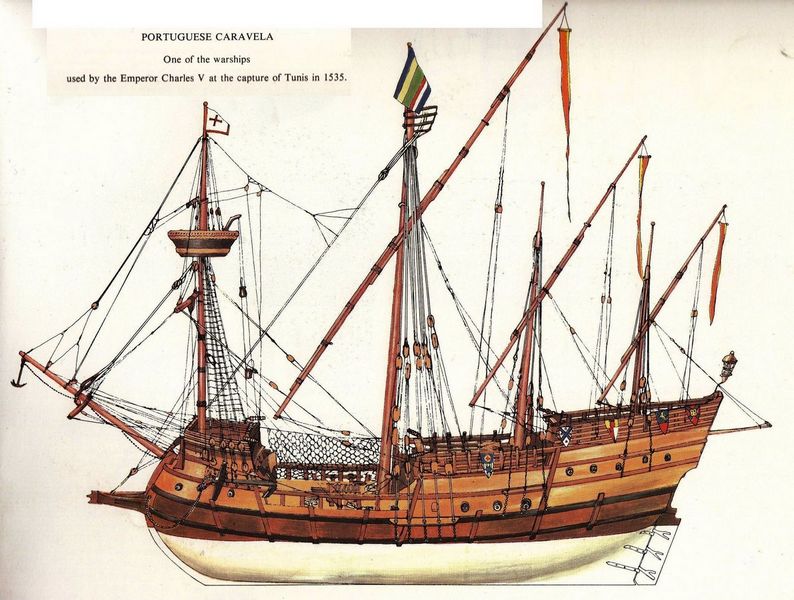
Caravel 1535
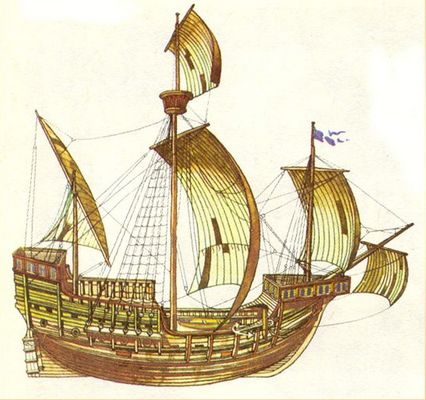
A carrack
Portugal: The Arabs took advantage of the fatal weakening of the Visigoths and invaded the Iberian territory, abolished the Visigothic kingdom, and became the masters of Hispania, who eventually began to be called Moors. Their state was named the Caliphate of Córdoba, after the capital of Iberia. The expulsion of the Moors began around the turn of the millennium. The name Portugal first appears in a document dated 938. The kingdom was proclaimed only in 1143 by Alfonso I, who recaptured it from the Moors in 1147 and made Lisbon his capital. The country reached its final extent under King Alfonso of Bologna, in 1249–51. The current border between Portugal and Spain was drawn in 1267. Portuguese maritime power was founded by King Denis the Peasant when he organized the Portuguese navy. His successor, Alfonso the Brave, actively supported geographical discoveries from the budget - a Portuguese-Genoese squadron again. discovered the Canary Islands after the Phoenicians. Portugal strengthened its relations with England: the two countries signed a treaty of friendship and cooperation in 1308. Columbus also returned to Lisbon from America.
**The origin of sawing was in Egypt:
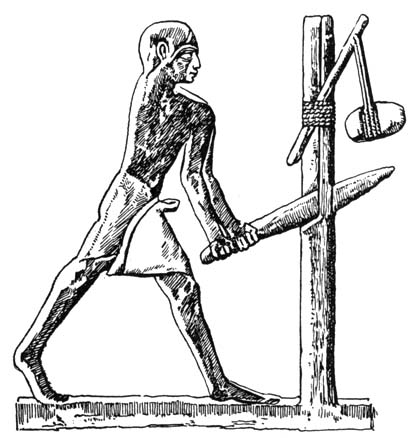
One of the reasons for the construction of keel boats was the advent of large iron saws suitable for sawing oak logs. In boat building, beams were cut to size with saws instead of being split with wedges. Boat building evolved from splitting and working planks to building beams:
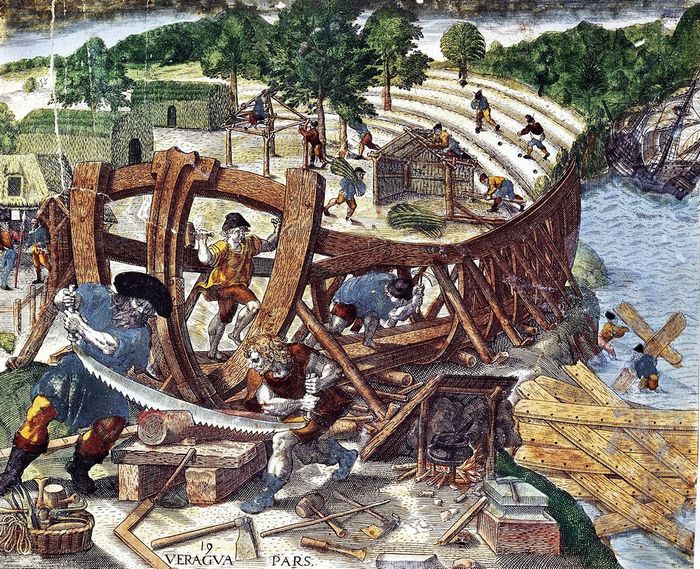
Around 1520, Pizarro in Peru. Carpentry work on the beams of a keel boat and a large iron saw (http://jollyroger.5mp.eu/web.php?a=jollyroger&o=GpuztuEbnS)
It is known that the Vikings built their ships from oak and pine wood using axes and adzes, splitting and hewing the wood. The axe used for shipbuilding is also called a adze. The Egyptians made it from flint and then bronze, but mainly from flint, because they did not have tin to make bronze. Copper is a soft metal and is not suitable for making tools. The Egyptians used arsenic bronze, a naturally occurring metal, and often recast their old tools. The planing process:
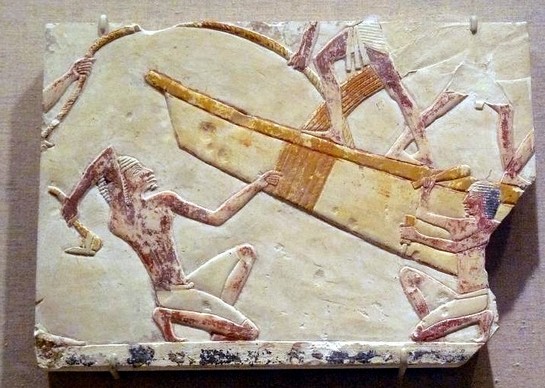
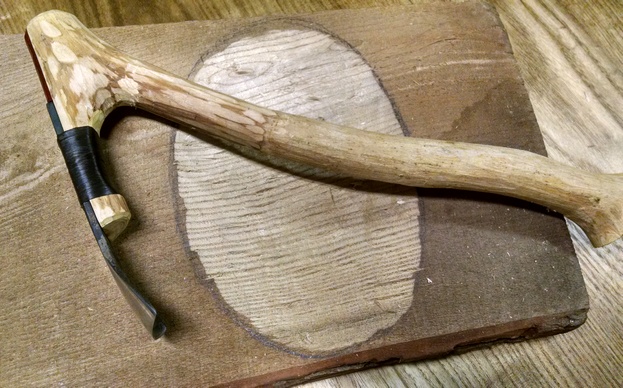
Throughout history, the head of the adze has been attached in various ways: it was tied to the wooden handle or its split, glued with tar in the north, or placed in a bone socket elsewhere. In the Middle Ages, iron-headed adzes were already in use, some with long handles. Two other tools used were the chisel and the saw. Other shipbuilding operations included splitting, hewing, carving, sawing, drilling, planing, and sanding.Kő- és fém hántoló balta (Wikipedia)

